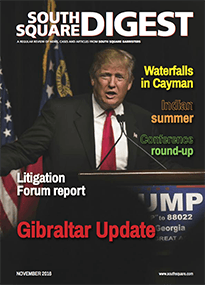

Following the recent High Court decision in BTI 2014 LLC v Sequana Richard Fisher considers what guidance it offers to directors wishing to pay shareholder dividends.
The existence of long-tail contingent liabilities is an unfortunately common feature of modern corporate groups. Actual and contingent asbestos liabilities drove the T&N group into insolvency. Other entities face liabilities for historical acts that they committed themselves, or as a consequence of successor liability which, despite the purchase of insurance, continue to grow beyond existing cover, and require ever more demanding provisions in their accounts. If the current business is being conducted profitably, and the accounts demonstrate sufficient distributable profits, is it open to directors of a company to pay dividends to shareholders if they have made a reasonable estimate of the potential liabilities faced by the relevant entity? Or is something more required? Should prudence prevail, and the monies be retained in order to cater for the possibility that the contingencies will vest and liabilities exceed those estimates? Issues of this type arose for consideration by the High Court in the recent case of BTI 2014 LLC v Sequana SA [2016] EWHC 1686 (Ch). Consider a scenario in which Company A faces potentially huge liabilities to indemnify a third party, B, for liabilities arising under the United States Comprehensive Environmental Response, Compensation and Liability Act 1980 (“CERCLA”). Based on matters of judgment by its directors, A’s accounts make a provision for these contingent liabilities in the amount of circa £50 million. But the extent, if any, of those liabilities is very uncertain. The provision is at a level that enables A’s directors to form the view that A is solvent, such that it is able to effect a reduction of capital and has sufficient distributable reserves in its accounts so as to enable it to declare dividends in two successive years to its parent company, C. C, shortly after receipt of the second dividend, sells A on terms which seek to ensure that it can have no possible liability for any CERCLA indemnity. However, in due course, the creditors of A allege that the provision in A’s accounts for the indemnity liability was manifestly inadequate. What remedies, if any, are open to the creditors of Company A to challenge the payment of the dividends to C? In BTI, Mrs Justice Rose considered an attack on the payment of dividends in circumstances broadly similar to the above on the three-fold basis that (i) their payment contravened the requirements of Part 23 of the Companies Act 2006 (the “2006 Act”) (because the accounts on which the directors relied were incorrect and did not give a true and fair picture of the state of the company’s finances); (ii) the decision to pay both dividends was in any event a breach by the directors of their fiduciary duties; and (iii) the declaration and payment of dividends constituted transactions defrauding creditors for the purpose of Section 423 of the Insolvency Act 1986 (the “1986 Act”). Ultimately, the claims failed other than in respect of the final dividend declared, which Mrs Justice Rose held (on the very specific facts of the case) contravened Section 423 of the 1986 Act. But the decision contains a number of useful findings as to the current state of the law that should provide guidance going forwards. At the heart of the attack on the dividends was the manner in which directors should approach the question of assessing the solvency of a company where it faces contingent liabilities.
A company can only make a distribution out of profits available for that purpose, and by reference to properly prepared annual or interim accounts that enable a reasonable judgment to be made as to the amounts of the items on which the justification of the dividends depends (Ss 830, 836 and 837 of the 2006 Act). In this instance, although the accounts purported to support the payment of dividends, they were predicated on the reduction of capital having been effective and the provision for the contingent liabilities having been appropriate. Where a reduction of capital takes place out of court in accordance with Chapter 10 of the 2006 Act, the reduction must be supported by a solvency statement (Ss 641 and 642). This requires (see judgment at [312]) a statement that each of the directors of the company has formed the opinion that (i) “there is no ground on which the company could then be found to be unable to pay (or otherwise discharge) its debts”; and (ii) that the company will be able to pay (or otherwise discharge) its debts as they fall due during the year following the date of the statement. This language (which is in substance mirrored in the context of solvency declarations given by the directors for the purpose of a members’ voluntary liquidation under the 1986 Act), and how stringently it will be interpreted, had not been the subject of any decision since the Supreme Court opined on the meaning of insolvency in Section 123 of the 1986 Act in Re Eurosail [2013] UKSC 28. In BTI, the issue concerned the first limb of the above test i.e. what was required for the directors’ statement of opinion that there was no ground on which the company could then be found to be unable to pay (or otherwise discharge) its debts? The conclusion reached is likely to give comfort to directors both in this context and when considering solvency statements in the context of voluntary liquidations. Upholding the validity of the reduction of capital notwithstanding the existence of the large contingent liabilities (which could ultimately greatly exceed the provisions made), the Court held that:
- The directors must in fact have formed the opinions required by Section 642 of the 2006 Act and applied the correct test in coming to those opinions (i.e. it is not enough that the directors acted honestly) [322]
- However, the requirement that there be “no ground” on which the company could be found at the date of the statement to be unable to pay its debts did not mean “on the worse case scenario”. As Mrs Justice Rose put it at [327]: “I hold that the opinion that the directors must form is not whether, if calamity were to strike on some or all fronts, the company might be unable to pay its debts nor is it whether the court would have jurisdiction to wind up the company under Section 123 of the Insolvency Act 1986 on a petition issued on the day the solvency statement was signed. The test is not a technical one but a straightforward one applying the words of the section. The directors must look at the situation of the company at the date of the statement and, taking into account contingent or prospective liabilities, form an opinion as to whether the company is able to pay its debts.”
- The phrase “taking into account contingent and prospective liabilities” carries the same meaning as used in Section 123(2) of the 1986 Act, and is to be construed in the same way as described in Re Eurosail (see [337]-[339]) i.e. not in a technical sense, but whether considering the nature of the contingent and prospective liabilities, assets would be available to meet them, and what provision has to be made for that purpose ([329] and [330]).
It is not necessary for the directors to have reasonable grounds for the opinion that they form (albeit it will be a criminal offence under Section 643(c) of the 2006 Act if they do not have reasonable grounds for the opinion that they hold). The effect of this will be that even if an offence occurs, the reduction of capital will still be valid ([331]-[333]). Applying the long standing decision of De Courcey v Clement [1970] 1
Ch 693, the Court further held that errors in the solvency statement (or statement of assets and liabilities on which the statement was based) would not invalidate the reduction of capital provided that the statement can be reasonably and fairly described as a statement of the company’s assets and liabilities ([318] and [343]). The reduction of capital was not, however, the only basis on which the dividends were attacked. The Claimants further asserted that the declaration of dividends were in any event invalid because the accounts did not give a true and fair view of the state of affairs of the company in light of the contingent liabilities that the company faced. In making a provision in the accounts, the claimants asserted that, even if a best estimate (in admittedly very complicated circumstances: [109]), the directors should have taken more account of the possibility that that estimate could turn out to be wrong “by a long way” ([6]). The estimated liabilities had covered a large range with (at certain times) a potential difference of more than $250 million between the low and high estimates in a worst case scenario (see, for example, [122] and [131]). This argument was also rejected. The Court noted (with implicit approval) the conclusion reached by various eminent Chancery silks over the last 3 decades that: “The requirement to prepare accounts which show a true and fair view is a legal requirement, the satisfaction of which is a question of law for the courts to determine. In determining that question, the Courts will rely very heavily upon the ordinary practices of professional accountants in determining whether accounts show a true and fair view. That is because those practices reflect the accumulation of experience and good practice and mould the expectations of the users of accounts as to the sufficiency and utility of the information in terms of quantity and quality” (see [372]). The Court also noted the definition in FRS 12 that a provision for a contingent liability should only be recognised when an entity has a present obligation (legal or constructive) as a result of a past event, it is probable that a transfer of economic benefit will be required to settle the obligation, and a reliable estimate can be made of the amount of the obligation. Unless those conditions are met, no provision should be recognized ([374] –[378]). Mrs Justice Rose therefore concluded that, provided a provision was reasonably included as reflecting the best estimate of those involved, the accounts would be regarded as giving a true and fair view of the company’s financial position even if it was possible that a much higher provision could (or, with hindsight, would) be justified (at, for example, [400] and [431]). Is it possible to argue that, even if the payment of dividends was valid for the purpose of Part 23 of the 2006 Act, the declarations amounted to a breach of fiduciary duties in circumstances where the directors were aware that the estimates used for provisions were surrounded by great uncertainty and there was a risk that the liability would be much greater than the estimate? The answer to this question appears to be a tenuous yes, albeit the circumstances in which such a claim could arise seem likely to be rather extreme.
Of potentially wider interest was the consideration given by the Court to the question of when a duty to take into account the interests of creditors may arise. Reliance was placed on the duty reflected in Section 172 of the 2006 Act to act in the way that a director, in good faith, considers would most likely promote the success of the company, and to take account of the interests of creditors (see in particular Section 172(3)). A number of aspects of the law in this regard were common ground and accepted by the Court as correct (see [460]-[463]) including that (i) the content of the duty does not vary according to the degree of risk of insolvency that has arisen, and (ii) that, if the court decides that the duty to take into account creditors’ interests has arisen but the directors did not in fact take the interests of creditors into account, that is not of itself a breach of fiduciary duty invalidating everything done automatically (applying Colin Gwyer v London Wharf (Limehouse) Ltd [2002] EWHC 2748 (Ch)). In determining when the duty to creditors may arise, the Claimants argued that it sufficed if there was a real as opposed to remote risk of insolvency. The Defendants argued that the company had to be “very close to insolvency”. Rose J conducted an extensive review of the authorities in this area (see [466]-[476]) and, agreeing with the judgment of John Randall QC in Re HLC Environmental Projects Ltd (in liq) [2013] EWHC 2876 (Ch), held that the language of a real risk of insolvency was, on analysis, in all cases treated as being analogous with notions of being “on the verge of insolvency” or “of doubtful or marginal solvency”. She stated at [478]: “The essence of the test is that the directors ought in their conduct of the company’s business to be anticipating the insolvency of the company because when that occurs the creditors have a greater claim to the assets of the company than the shareholders.” Having expressed the applicable test broadly, she therefore concluded that, in circumstances where there was a real possibility that the company would never become insolvent or even close to insolvent, the company could not be described as being on the verge of insolvency or of doubtful insolvency or in a precarious or parlous financial state. Therefore, the directors could not be said to be required to run the company in the interests of the creditors rather than the shareholders of the company (see [483]). Whilst not impossible, it seems unlikely that a Part 23 compliant declaration of a dividend will in many cases be capable of being challenged as being in breach of the director’s fiduciary duties to take into account the interests of creditors. It is therefore a little surprising that, having reached this conclusion, the challenge to one (but not both) of the dividends declared succeeded as being a transaction defrauding creditors within the meaning of section 423 of the 1986 Act. Section 423 requires inter alia that the directors had the subjective purpose of putting assets beyond the reach of creditors, and that this was a real or substantial purpose of entering into the transaction (IRC v Hashmi [2002] EWCA Civ 981 and Hill Spread Trustee [2006] EWCA Civ 542). The Court rejected the argument that a payment of a dividend could not fall within the scope of Section 423 (on the basis that it was a discretionary decision to pay assets to members which moved them from the debtor to a third party, irrespective of the source of their entitlement i.e. the original articles): [500].
However, it went on to hold that, although there was no evidence of the relevant purpose at the time that the first dividend was declared, the second was declared at a time when sale of A by C was in contemplation. The fact that it was declared in order to facilitate that sale (which sale would remove a potential responsibility for environmental liabilities from the group balance sheets), did satisfy the purpose requirement of Section 423. This appears to be a somewhat surprising conclusion and, with respect, the submission made by the Defendants in response to this argument appears to have force (see [512]): that the purpose of the sale may have been to remove the liability from C’s group, but the transaction which was being challenged was the declaration of the dividend. The Judge rejected this argument on the basis that linked transactions may be attacked under Section 423, and that it was not possible to distinguish the purpose of paying the dividend and the purpose of selling the company. However, the transaction that deprives the company of value in this instance was the payment of the dividend. It was not a necessary part of the declaration of the dividend that there was also a sale of A by C’s corporate group: there were two self-standing transactions. The purpose of the company in paying the dividend does not appear to have been to deprive the creditors of recourse to that asset: on the contrary, on the evidence it appears to have been clear that leaving assets in A that could otherwise be used for dividends might increase the likelihood of claims being made. The purpose of the sale may have been to ensure that C’s corporate group no longer had a member within it that was potentially subject to the risk of claims arising under or as a consequence of CERCLA, but that is a purpose relating solely to the sale. The transaction that the claimant really wanted to challenge was the sale (as the passage at [516] of the judgment suggests): “Here there is no doubt that the substantive intention of the directors at the time of the May Dividend and the sale was to prevent AWA having any legal or moral call upon its parent company to meet its creditors’ claims” The transaction that eliminated any legal or moral ability of A to call upon C was the sale, not the declaration of dividend. But the sale was not a transaction entered into by A causing prejudice to its creditors by putting assets beyond their reach. The fact that the declaration of the dividend was a pre-cursor to the sale ought not to mean that it is a transaction susceptible to challenge under Section 423, or that the purpose of the sale was also a substantial purpose of the declaration of dividend. This issue will be revisited on appeal and may also be relevant to the point that the Court did not determine at the first trial, namely the remedy (if any) that would be ordered (see [525]). Assuming the decision to be upheld on appeal in all other respects, it provides helpful guidance for directors whose shareholders want dividends to be paid notwithstanding the existence of material contingent liabilities.







![Brake & Anor v The Chedington Court Estate Ltd [2023] UKSC 29](https://southsquare.com/wp-content/uploads/2024/02/Brake-Anor-scaled-e1728649908896.jpeg)







